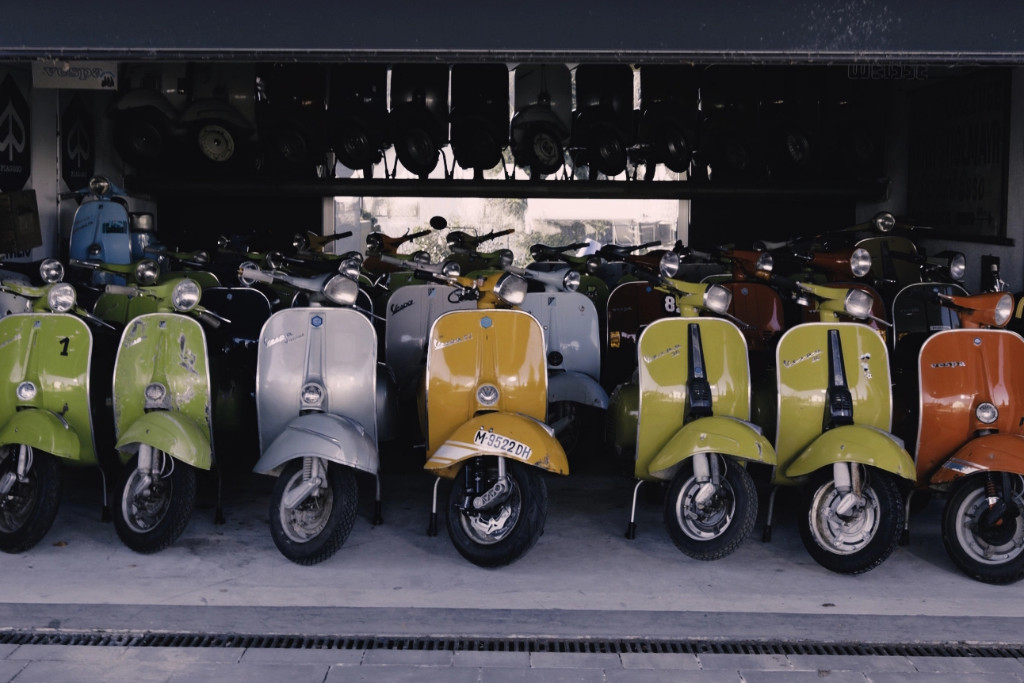Vespa Smallframes in their origin and popularity
In the early 60’s people started talking about the Vespa Smallframe series. Piaggio sold over 2 million units, but they wanted to expand and release a new model range. Young people over 14 were now the focus, as well as the ladies who were also excited about the Vespa. So a more compact frame was developed. The lightweight body meant that even young and slim people could steer and control the vehicle more easily. And so the first smallframe model was launched in 1963, the Vespa 50, which became smaller in all dimensions. The side hoods were firmly integrated and anchored in the sheet metal frame. A small engine hatch was integrated on the right and the sheet metal cascade was replaced by a plastic cascade on the Vespa 50. New vigor also came under the hood with a redesigned engine and a 45 degree angled cylinder. In addition, the electronic ignition was the focus here.
Vespa models overview
A year after the Smallframe series, the Vespa 50 N was launched with color changes and technical innovations. Only some new approaches of the vehicle were the extended wheelbase, a different engine housing, a deviating frame length and an enlarged engine flap. The changes were also found on the Vespa 50 L and 50 R.
Limitation of a model
As an anniversary model of the 3 millionth vehicle, the 50 N was limited to 3000 copies. More sporty and visually appealing was the Vespa 50 Super Sprint from the mid-60s. It was also superior to the other models in terms of performance. The optical appearance was different, because the handlebars were narrower and dropped, as well as the fender were changed. The seat could be folded back instead of forward, and the leg shield and seat were installed differently. There was also a spare wheel with a matching painted hubcap in the toolbox. In the same year followed parallel also the Vespa 90 in the stores, of which the engine resembled the smaller V50 counterpart and the stroke was extended to 51 mm. In addition to 90 cc more power, it was identical in construction to the Super Sprint.
Vespa as a new edition
Today, the two vehicles are the rarest of the Smallframe range and are highly prized by enthusiasts. High prices are also achieved. The Vespa 90 was used as a racing series at the time and reached up to 86 km/h. A new challenge was presented by the Vespa 125 Nuova and Primavera, which combined many features of their two predecessors. The 10-inch tires and the 125 cc displacement were new. The Primavera was the successor to the Nuova model after 3 years. Here there was additional storage space on the left in the side hood and 6 hp more lay under the hood.

© Khaosaming, Wikipedia, CC BY-SA 3.0
Even more Vespa models through the ages
1969 was the year of changes in the 50 series of Vespa. The models Vespa 50 Special and Elestart were launched, which had a rectangular handlebar head and cascade, 10-inch tires and optimized brakes. Over time, the visual characteristics of the Vespa also changed. The 125 Primavera ET3, for example, hit the stores in 1976 with electric ignition and three over-flow ports. Exhaust and compression ratio here increased the performance of up to 90 km/h with a whopping 7 hp.
Various combinations of the Vespa range
The last model in the series was the Vespa PK 1983, which had the typical 80s style with angular shapes. Handlebars and cascade made of plastic were no longer directly connected to the frame and was very similar to the PX series. It had electric ignition, a 4-speed manual and better turn signals, as well as an extra storage compartment. From 1990, the PK 50 XL 2 had a new steering design, as well as more advanced technology and a modified body. There was also a sports version.
Vespa – old or rather new vehicles?
Only a year later came out PK 125, which was identical to the PK 50 moped models. And so all these models came on the market. Many still enjoy their popularity today and are driven not only by fans and classic car enthusiasts. Young people also appreciate the Vespa as their first vehicle. It is light, has a low consumption and can be steered well. Unfortunately, in recent years, a lot of mass-produced new models. This was not yet the problem in the time of Vespa production. Because back then, in the 60s, the electronics were not as pronounced as today, but simpler and easier to repair.




These are classic Vespas that have, no doubt, stood the the test of time. I’m wondering if the GTS will be this revered in the coming years, as in my opinion, Vespa, in respect of the shape and styling seem to have lost their way somewhat, and these new models have very much a Japanese influence. I would like to see a return to the style of the Italian scooters which were, and are still an iconic design